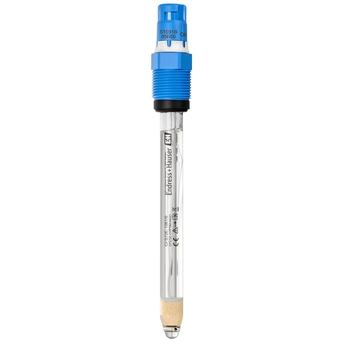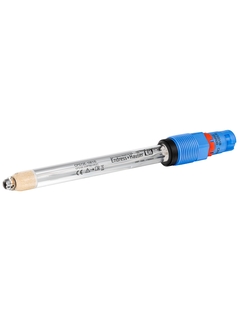-
Measuring principle
Sensor ORP / Redox
-
Application
Process technology and monitoring of processes with:
• Rapidly changing ORP values
• High proportion of electrode poisons, such as H2S -
Characteristic
Digital ORP electrode for chemical process with an ion trap for poison-resistant reference
-
Measurement range
–1 500 to 1 500 mV
-
Measuring principle
Gel compact electrode with ceramic junction
-
Design
All shaft lengths with temperature sensor
Advanced gel technology -
Material
Sensor shaft: Glass to suit process
ORP measuring element: Platinum
Metal lead: Ag/AgCl
Open aperture: Ceramic junction, zirconium dioxide
O-ring: FKM
Process coupling: PPS fiber-glass reinforced
Nameplate: Ceramic metal oxide -
Dimension
Diameter: 12 mm (0.47 inch)
Shaft lengths: 120, 225, 360 and 425 mm
(4.72, 8.86, 14.2 and 16.7 inch) -
Process temperature
0 to 140 °C (32 to 284 °F)
-
Process pressure
0.8 to 14 bar (11.6 to 203 psi) (absolute)
-
Temperature sensor
NTC 30k
-
Ex certification
With ATEX, IECEx, CSA C/US, NEPSI, Japan Ex and INMETRO approvals for use in
hazardous areas Zone 0, Zone 1 and Zone 2. -
Connection
Inductive, contactless connection head with Memosens 2.0 technology
-
Ingress protection
IP68
-
Additional certifications
Additional certifications
Field of application
Memosens CPS72E is the digital specialist for demanding processes. Its unique, contamination-resistant reference guarantees stable measurement in poisoning media but also in media with low conductivity. Thanks to Memosens 2.0 digital technology, CPS72E combines maximum process integrity with simple operation. It resists moisture, enables lab calibration and offers extended storage of calibration and process data providing the perfect basis for predictive maintenance and IIoT services.
Processes in chemical industry and monitoring of processes with:Quickly changing ORP valuesHigh proportion of electrode poisons such as H2S With ATEX, IECEx, CSA C/US, NEPSI, Japan, INMETRO approvals for use in hazardous areas, zones 0, 1 and 2.
Benefits
Memosens 2.0 offers extended storage of calibration and process data, enabling better trend identification and providing a future-proof basis for predictive maintenance and enhanced IIoT services. The sensor resists strong acids and bases and high organic loads. Its unique ion trap prevents poisoning of the junction and reference, ensuring a long sensor lifetime.Non-contact, inductive signal transmission maximizes process safety. Reduced process downtime and extended sensor lifetime minimize operating costs.


